South America has produced some phenomenal and out-of-this-world talents who, over the years, went to the Portuguese league, like Ángel Di María and James Rodríguez or, more recently, Enzo Fernández and Luiz Díaz.
Besides their exceptional technical quality, these South Americans also brought their aggressiveness and passion to the European game.
Another talented name who has been recently linked to a big club in Portugal is the 22-year-old Alan Varela.
Currently playing for Boca Juniors in Argentina, the midfielder was approached by Sergio Conceição‘s FC Porto, who seems open to offering around 12 million euros to have him in this season’s roster.
Such interest came up to substitute one of FC Porto’s most influential players of the last few seasons, Matheus Uribe, who left for Al Sadd from Qatar.
Although with some differences, especially off the ball, we found a lot of similarities between these two midfielders.
If such a move occurs, we expect Alan to become an even better and complete player due to the Portuguese manager’s high tactical and physical rigour.
Yet, with some final details to discuss, the Argentinian still is in contract with “Los Xeneizes”, and some other top European clubs like Liverpool and Machester United can join the race to have the midfielder.
In this Alan Varela tactical analysis, we’ll dissect Alan as a player and his way of understanding the offensive and defensive game.
Furthermore, we’ll also see where and how Varela can add value to FC Porto’s game by filling Matheus Uribe’s void in the squad.
Alan Varela Style Of Play
To understand Varela’s style of play, we will do a small and quick overview of Boca Juniors’ tactics.
They play in a general 4-3-3 with a single pivot, yet during and after the build-up, this model has some changes.
So initially, they play with two pivots to assist the teammates in the offensive organisation process, and Alan is one of them.
Varela stands out as the only pivot of the team.
Moreover, the right-back tends to form a three-man backline with the other two centrebacks and leaves the deepness and width to Valentín Barco.
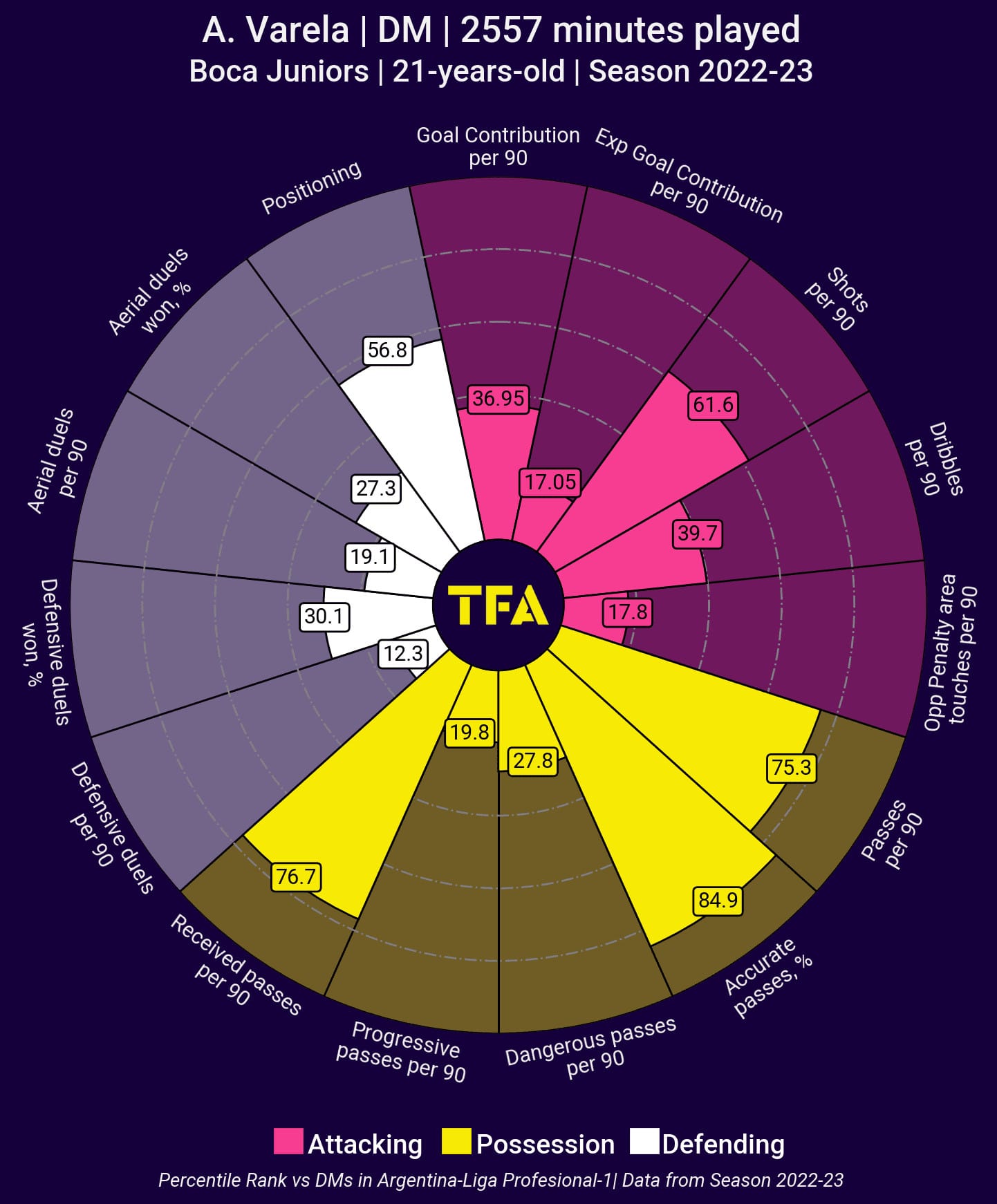
Generally speaking, Alan Varela is characterised by his refine and top-quality touch in possession.
He feels comfortable seeking his open colleague through a short or long pass or dribbling his opponents in a short space.
Let’s refer to some of the available data; according to the above radar, we can understand that Argentinian is above average in terms of passing since he ranked in the 84.9th percentile on accurate passes.
However, this stat can be misleading due to the player’s position and the type and amount of such passes.
For example, if we are talking of a centre-back who plays in a team who, through possession, controls most of the game, it is natural that he will have to risk less, and it will be most likely to have a high pass efficiency stat.
We looked deeply into Varela’s stats and concluded that he really stands out from his league in his technical features.
According to Wyscout, he has an 80% of accurate passes into the final third and 78% of pass efficiency in forward ball plays.
We strongly believe that a player who excels in such a technical attribute in a highly intense and aggressive league is likely to thrive in Europe.
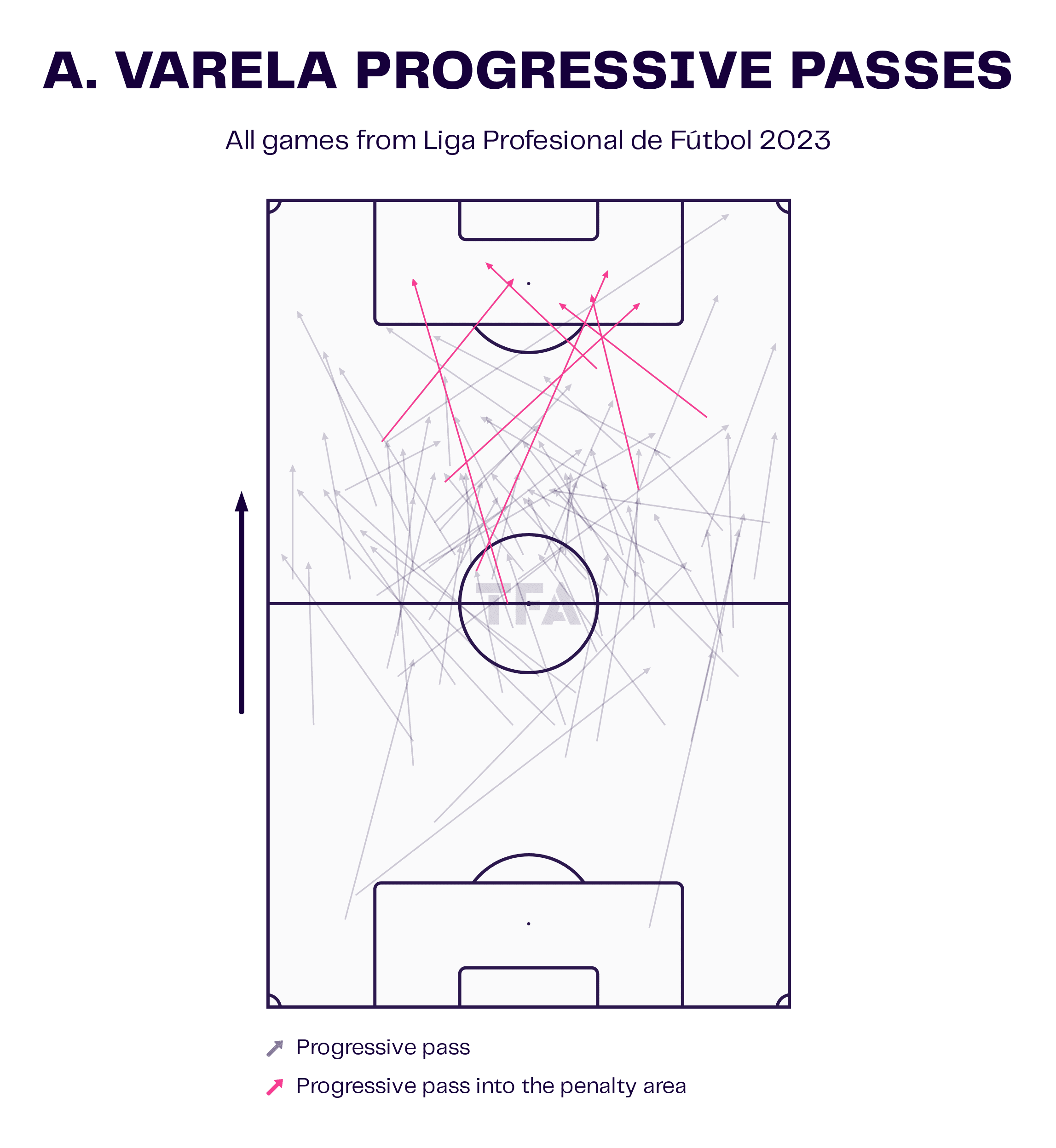
Because he plays right in front of Boca’s backline, Alan still has a low direct influence on goals; for instance, he ranked in the 36.95th percentile on goal contribution per 90 minutes.
Yet, as we have seen previously, this player has often shown both good vision and good technique to make the last pass.
In the image below, we can see what he can do in a more advanced zone of the pitch.
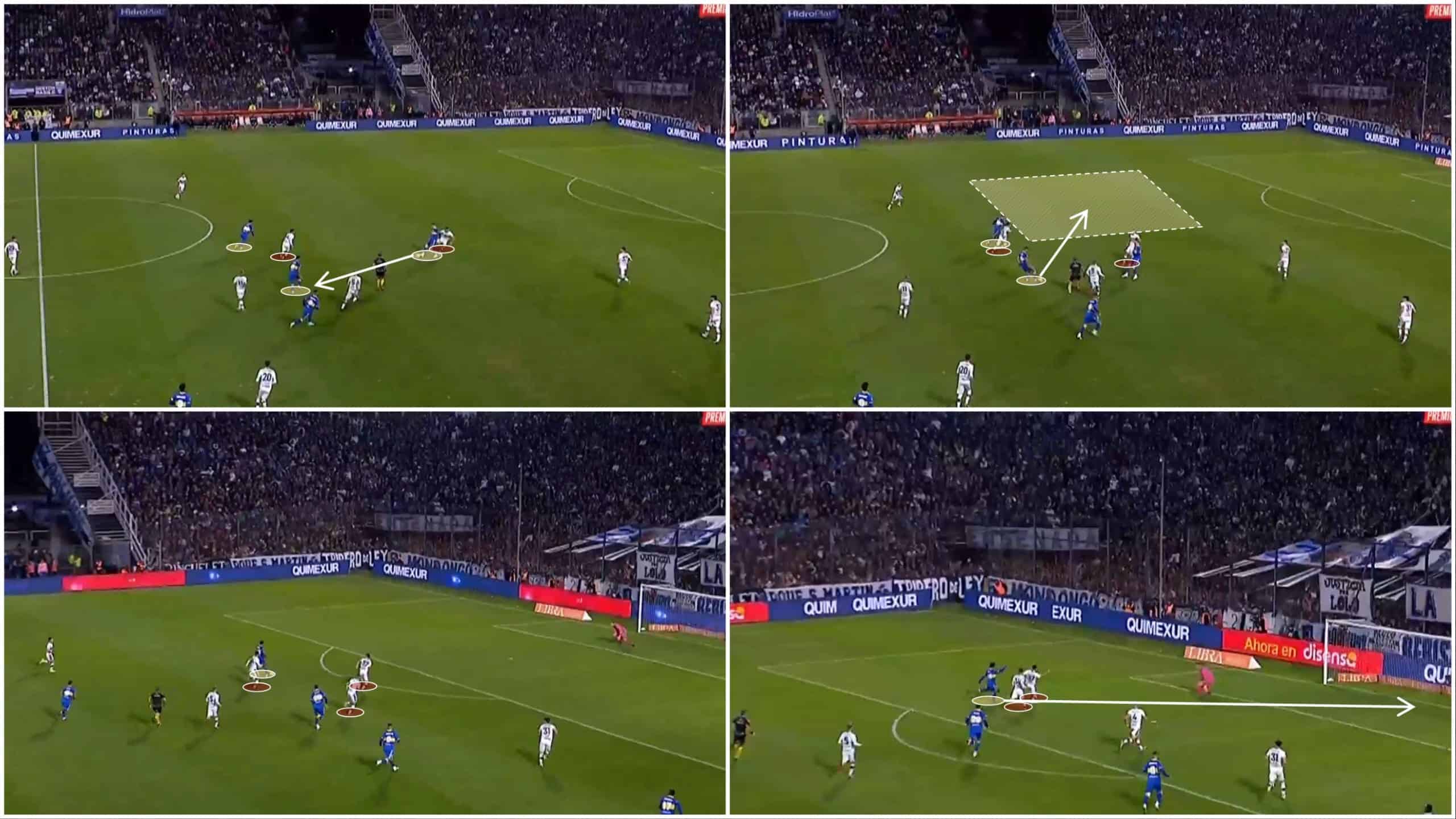
In our view, one of the features that can negatively affect the 22-year-old Argentinian is his physical stature.
Even though he’s pretty aggressive, as we are going to see further, Alan still has some difficulties in the duels disputed during the game.
Yet, he seems to be quite mobile and endowed with a decent pace, which helps him both on and off the ball.
Let’s now focus on the other area where Varela stands out: his tactical awareness.
Varela’s way of play as a pivot is quite rare in Argentina or in any other South American league, where it’s played a more direct and less paused game.
As a pivot, he has multiple functions, but two of the most important ones are to dictate the rhythm of the game and to be a team’s horizontal and vertical connecting link.
We are going to see further that he seem to do both.
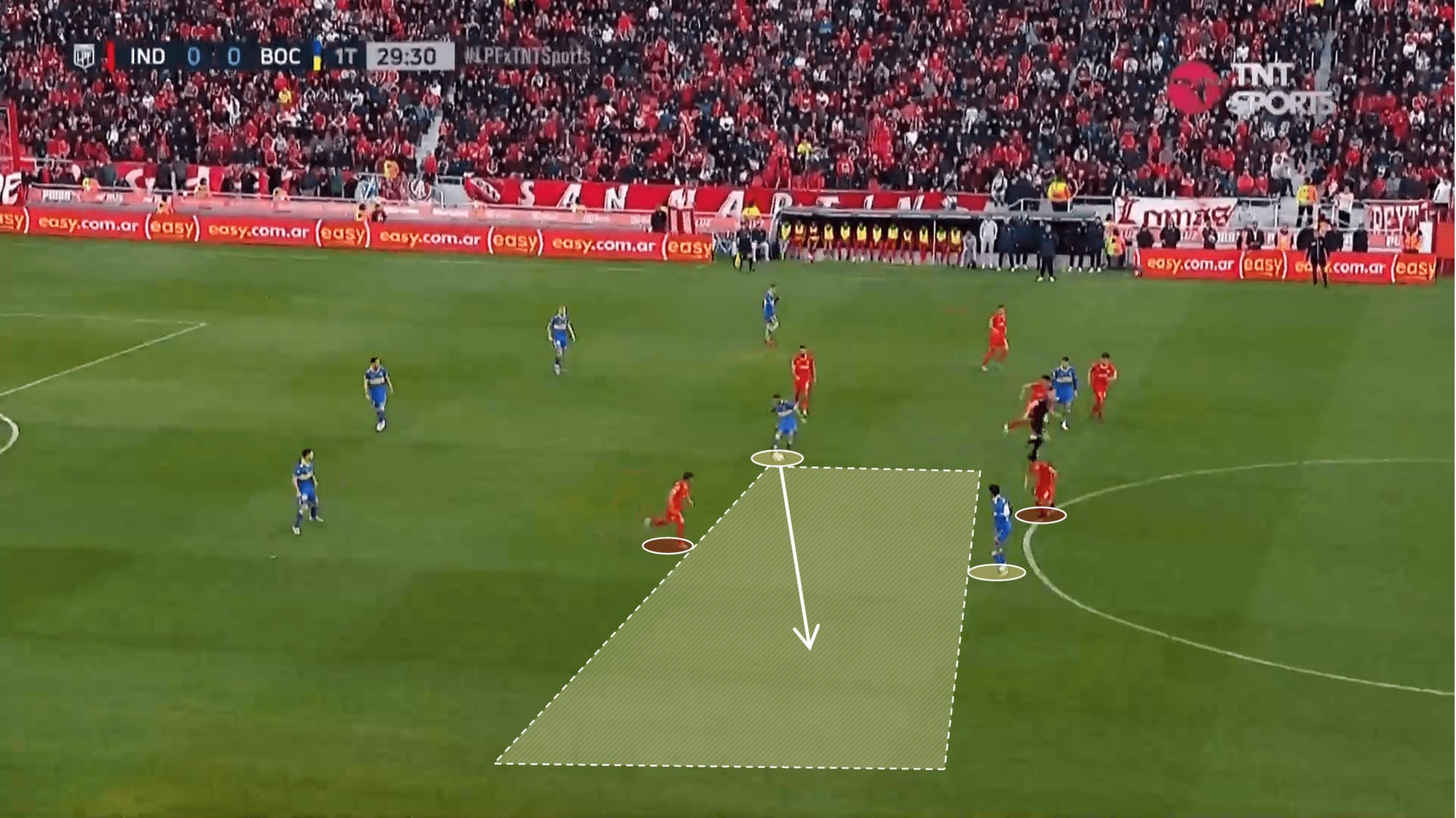
As we can observe in the above image, the ability to simplify what’s difficult is one of the most challenging tasks for defensive midfielders, yet if done correctly can improve both the individual and the collective.
He also seemed to be an intelligent player concerning his positioning, where he seems to be always looking for free space.
As we mentioned in our previous articles, mobility can be the key to success in possession, and as an example, we have the image below, which shows that exact situation.
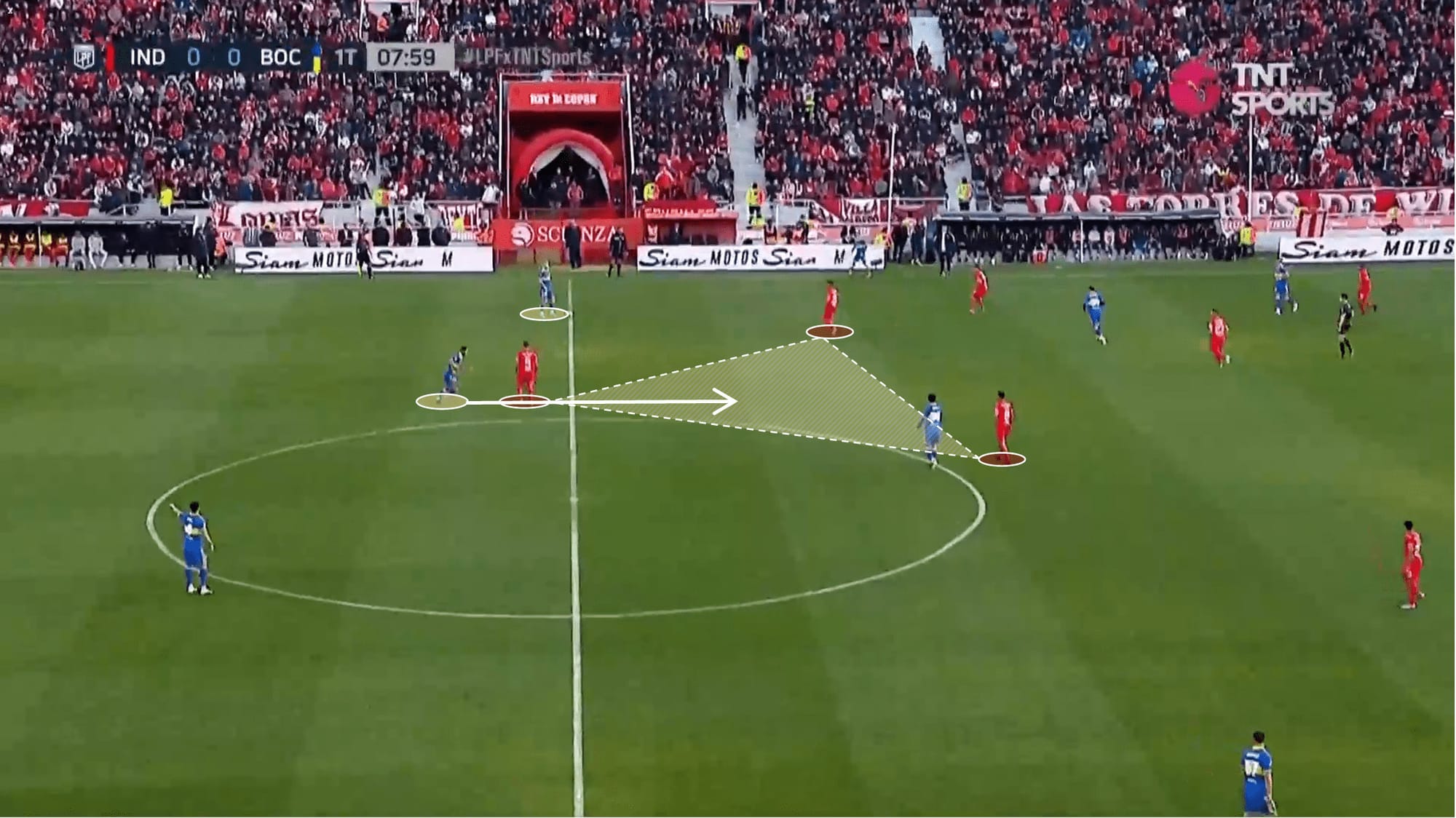
As another example, Varela, in the image below, seems to get the idea that the central zone of the midfield is too crowded, and as a result, he descends right into his team’s backline.

A feature that we found curious in Varela’s game was his behaviour right after the pass had been made.
Usually, the pivot is a more masculated and less mobile player, and as it goes, when the pass is made, his positioning does not change that much.
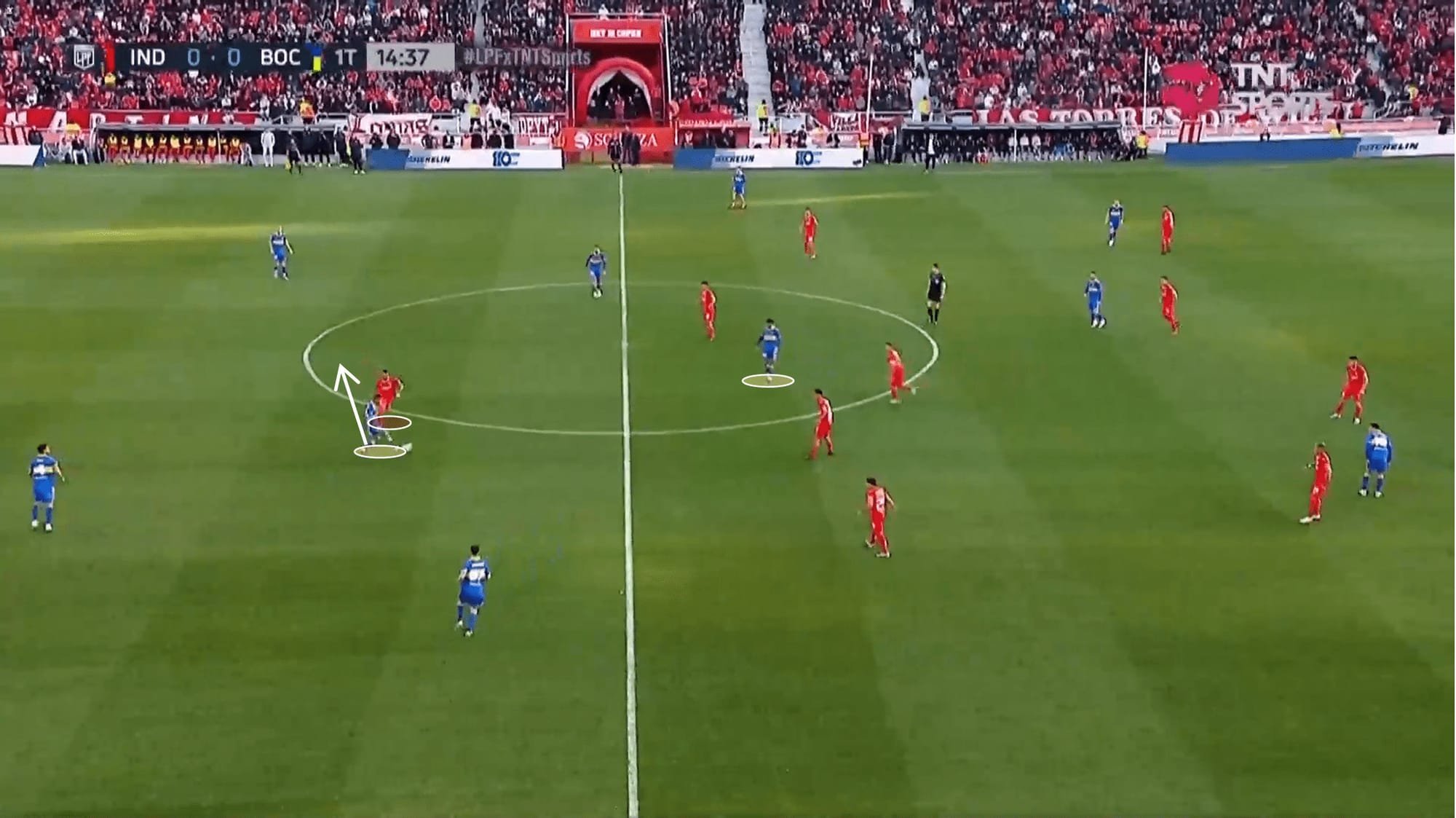
Yet, the Argentinian seems to be right the opposite; after the pass is made, he immediately looks for another available space so that his colleague can have an extra option during his decision-making.
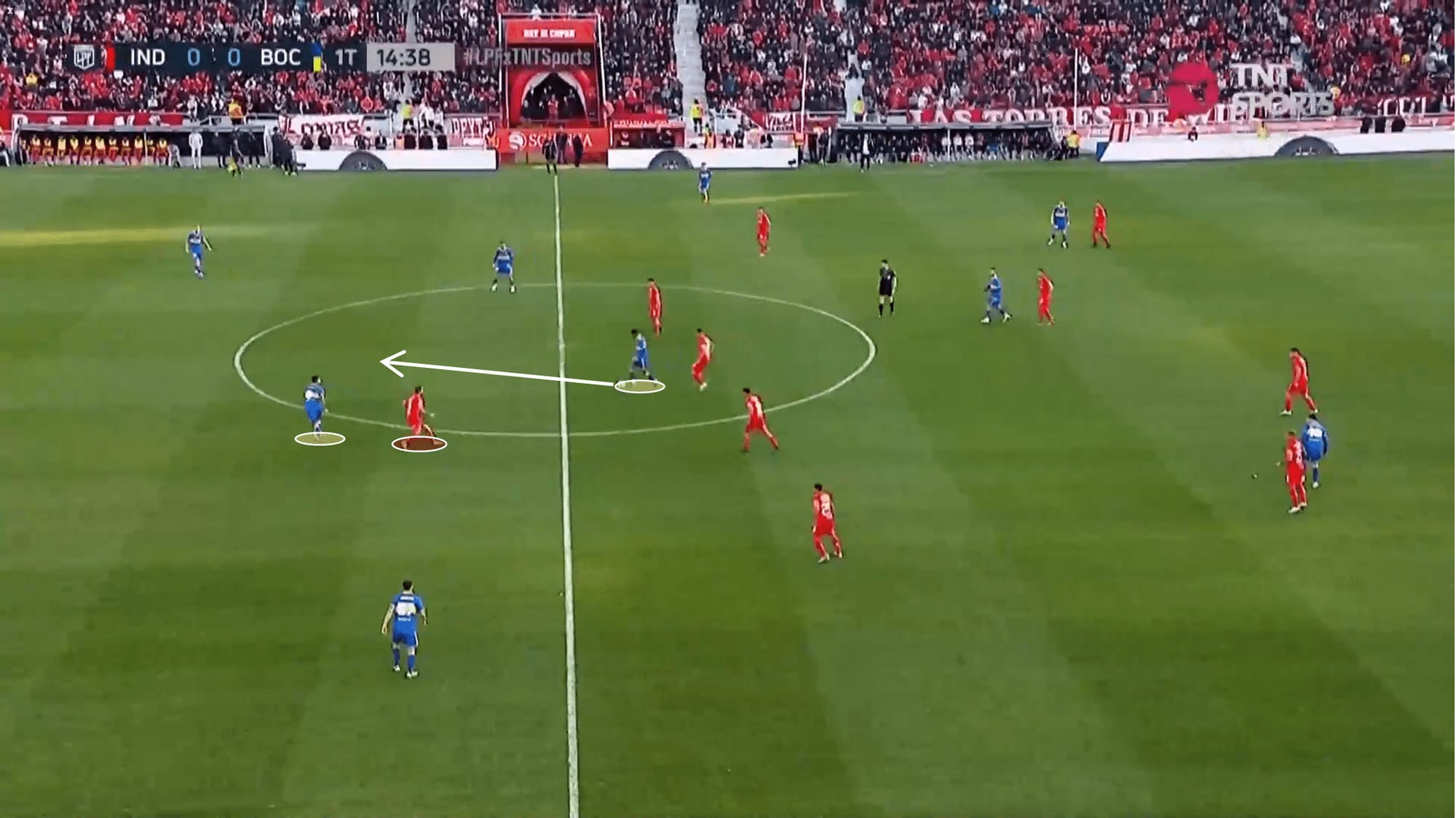
Although less frequent, Alan can add quality and an extra element to his game through his dribble.
A technically gifted player that, even though playing as a defensive midfielder, can transport the ball from a more backtracked zone of the pitch into the opponent’s half.
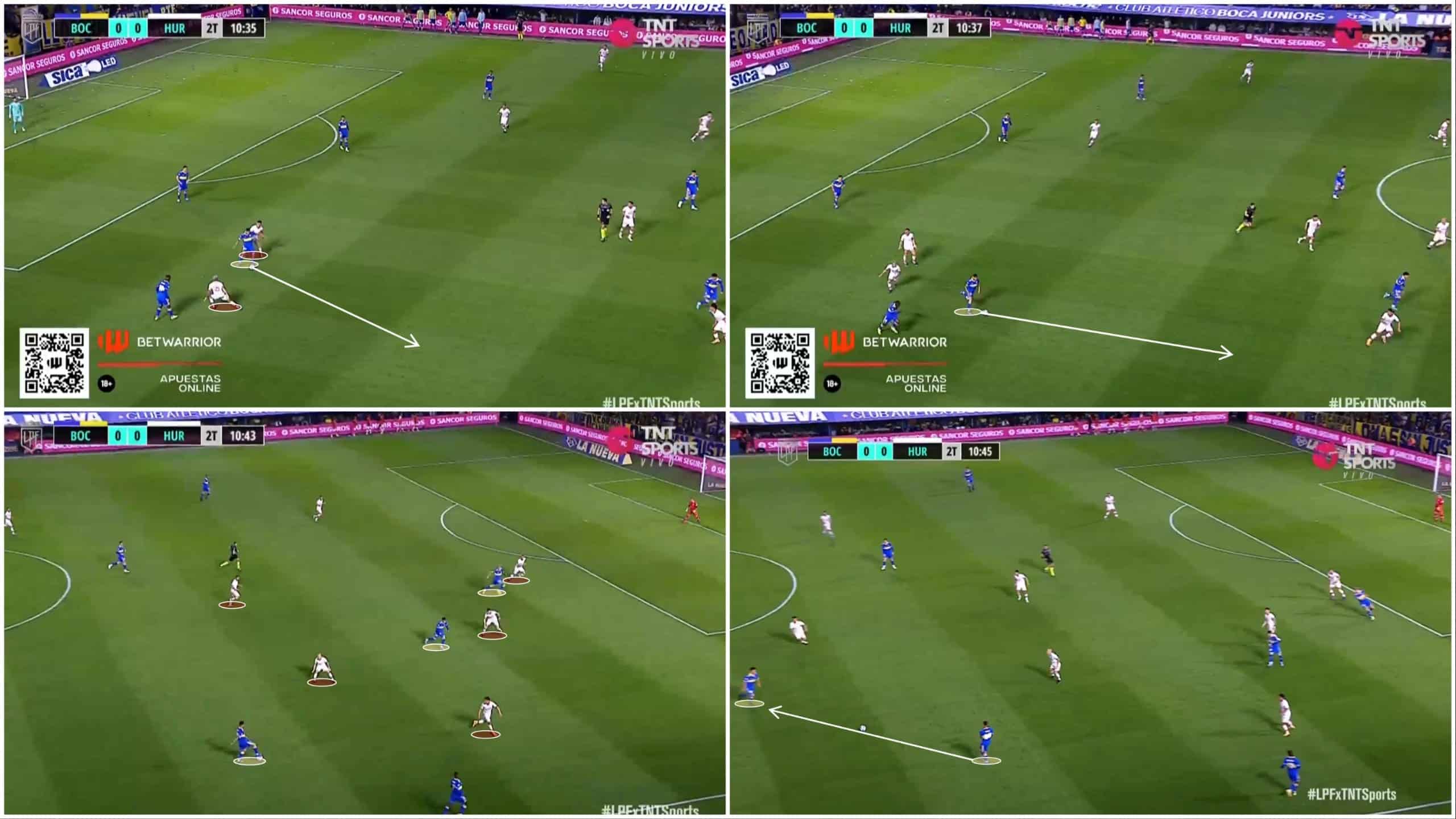
Yet the sequence also shows Varela’s tactical understanding, where in a numeric inferiority situation, he decides not to progress with the ball and instead chose a back pass.
Resorting to Wyscout, in 2023, the Argentinian made 17 dribbles, of which 11 were successful, meaning a 60% success rate in such a stat.
Alan Varela as a Matheus Uribe substitute
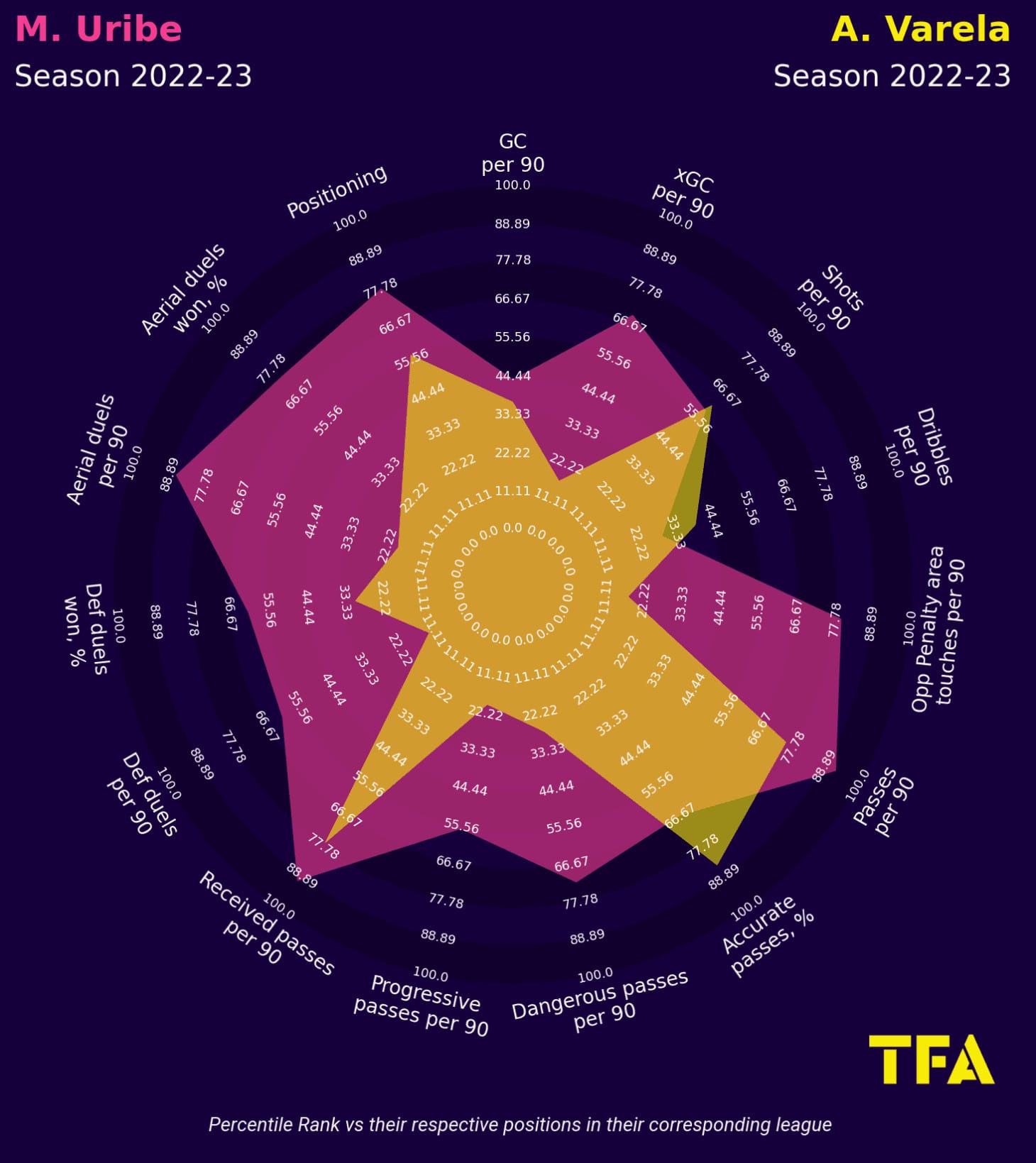
Following the above radar, it is perceptible that Uribe’s out possession domain over Alan Varela.
It can be explained by the Colombian’s height (1.83 meters) and especially by his strength, which allows him to win lots of duels.
His physical is something that, in our view, Alan should improve on, even if the move to Portugal does not happen.
After all, the Argentinian league is still one of the most aggressive and physical, and if Varela increases his physic, even his aerial contests would most likely be perfected and improved.
However, it would be unfair to make this comparison without mentioning that Uribe is 10 years older than Varela and also that FC Porto plays in a different system than Boca Juniors.
The experience can give some advantages, especially in some details on and off the ball, yet the system can significantly influence the statistics of both players.
For example, FC Porto with Uribe used to play in a 4-4-2, with Uribe often playing as a more backtracked midfielder, yet crucial in the offensive process.
This system allowed him to approximately rank in the 67th percentile on expected goal contribution per 90 minutes and to score five goals last season.
In this 4-4-2 system, we foresee Alan as a much more convincing player in the offensive process without neglecting his defensive obligations.
In this model, finding the perfect equilibrium is the key to playing as a more defensive midfielder, and Uribe was wise enough to become a consistent piece of such a puzzle.
Even though, as we saw, the Argentinian has shown some defensive weaknesses, he stands out in a particular and essential aspect of the game; we are talking about his positioning awareness while defending.
As a matter of fact, this was one of Uribe’s primary qualities and maybe one of the most significant requirements to play under Sergio Conceição as a midfielder.
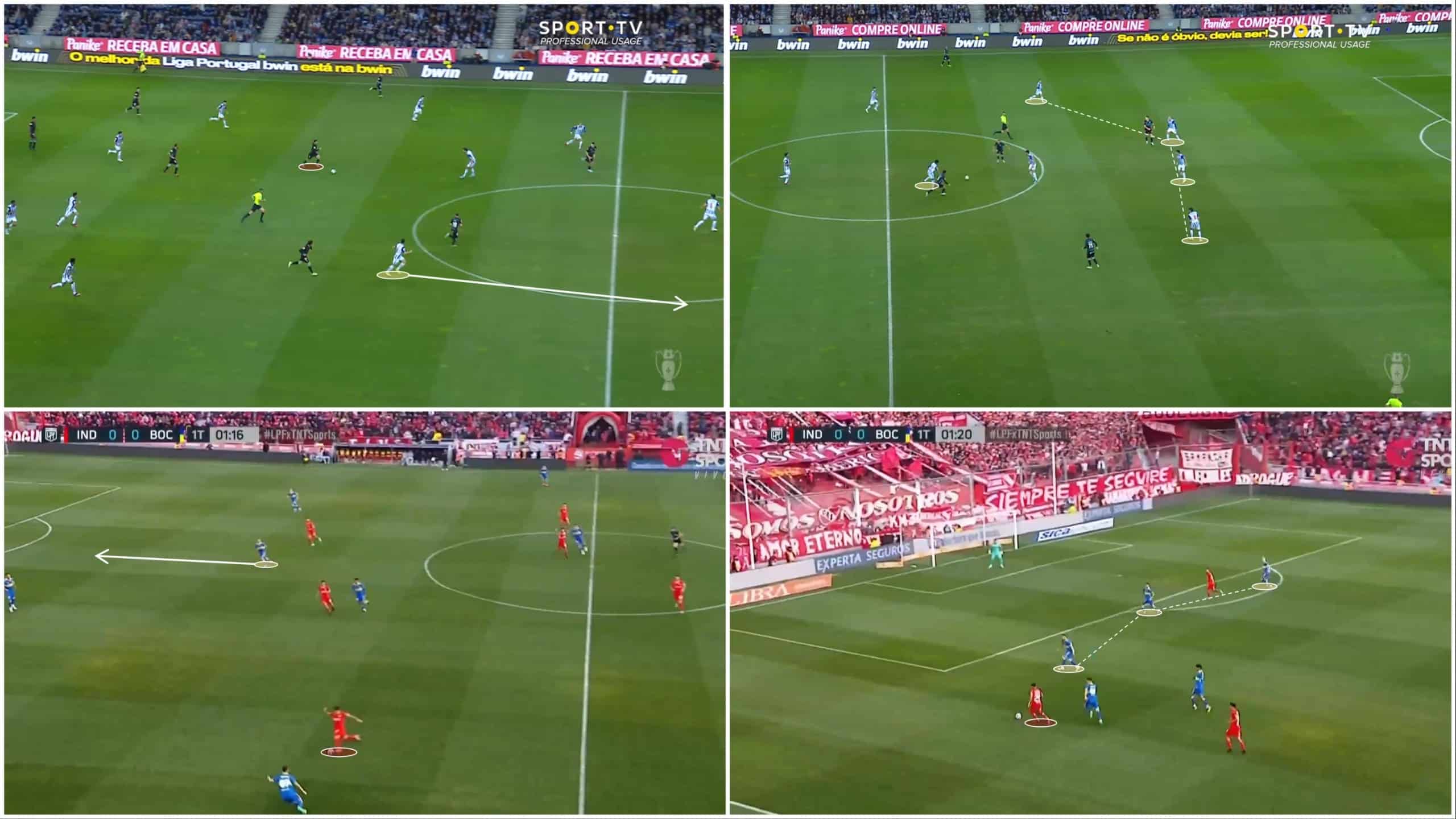
More specifically, the covered and uncovered ball concepts must be reasonably well-defined.
If we are talking about a pivot, then the uncovered ball situations have higher priority due to the importance of defending the space on the defender’s and midfielder’s back.
For example, as we can see above, a very common Alan Varela move is the integration of the defensive line.
At the same time, the defence is disorganised right after a loss of possession.
We also think the Argentinian often uses a correct body shape, which can be decisive during a defensive transition situation.
Because the Portuguese type of game is more paused and less exposed to counterattacks, it will be less unlikely to see Alan in the backline controlling the depth, yet it can happen.
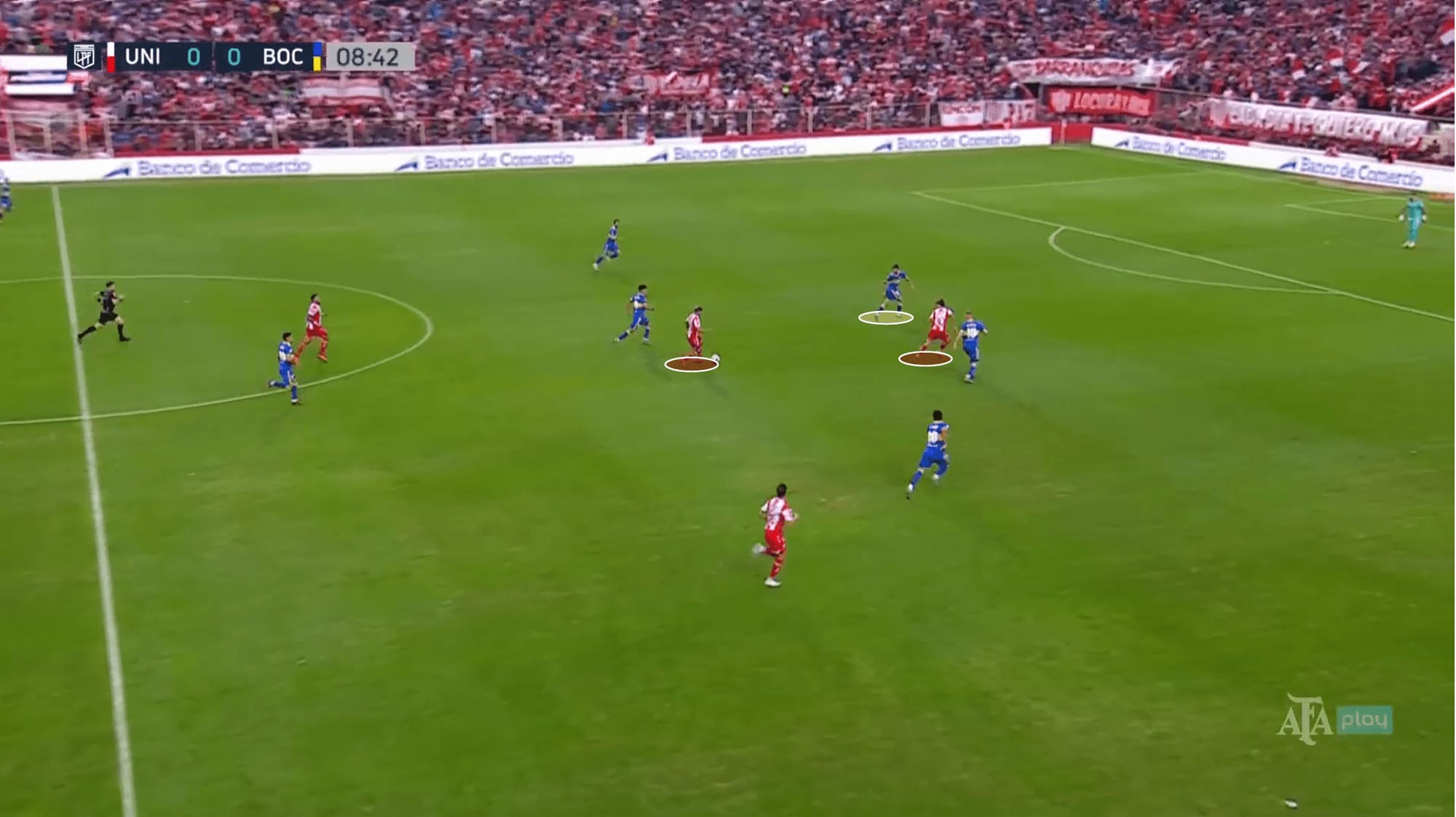
Conclusion
Even though he played all 90 minutes in the last Copa Libertadores game against Nacional from Uruguay, a summer move to FC Porto will likely happen.
In this Alan Varela scout report, we concluded that Alan is a technically gifted player with an above-average tactical understanding, which can help him adapt to a new league.
Yet we also came up to the conclusion that Varela should work on his strength in order to improve his off-possession stats, more specifically in his direct duels with the opponent.
We finished our analysis with a brief comparison between Varela and the former FC Porto pivot, the Colombian Matheus Uribe, taking into account some differences in the game model.
Even though they have 10 years of difference, we think the Argentinian can be a suitable replacement for Uribe’s departure due to his technique and sound decision-making in and out of possession.






Comments